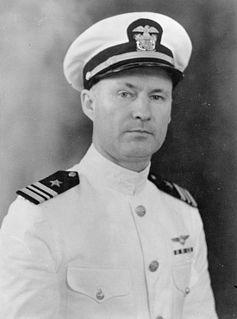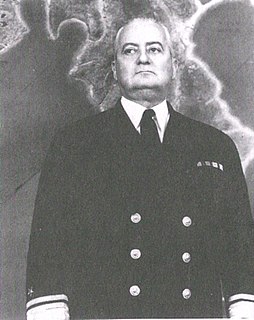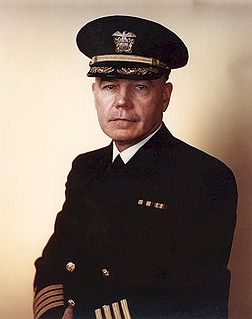
USS Nevada (BB-36), the second United States Navy ship to be named after the 36th state, was the lead ship of the two Nevada-class battleships. Launched in 1914, Nevada was a leap forward in dreadnought technology; four of her new features would be included on almost every subsequent US battleship: triple gun turrets, oil in place of coal for fuel, geared steam turbines for greater range, and the "all or nothing" armor principle. These features made Nevada, alongside its sister ship Oklahoma, the first US Navy "standard-type" battleships.

Arthur LeRoy Bristol, Jr., was a vice admiral in the United States Navy, who held important commands during World War I and World War II, and was an early aircraft carrier commander.

Charles Emery Rosendahl was a highly decorated Vice Admiral in the United States Navy, and an advocate of lighter-than-air flight.

Aubrey Wray Fitch was an admiral of the United States Navy during World War II. A naval aviator, he held important aviation-related commands both at sea and on shore from the 1920s onward. He also served as Superintendent of the United States Naval Academy.

Thomas Charles Hart was an admiral in the United States Navy, whose service extended from the Spanish–American War through World War II. Following his retirement from the navy, he served briefly as a United States Senator from Connecticut.

Admiral Samuel Shelburne Robison CB, USN was a United States Navy officer whose service extended from the 1890s through the early 1930s. He held several major commands during World War I, and from 1928 to 1931 served as Superintendent of the United States Naval Academy. In 1933, Admiral Robison also founded a Naval Preparatory Academy in Pine Beach, New Jersey called Admiral Farragut Academy.
Lewis Hancock Jr. served in the United States Navy during World War I as a submariner. He later became a naval aviator. His father, Lewis Hancock, was a prominent banker and served as the mayor of Austin, Texas from 1895 to 1897 while also creating the first public golf course, which today remains as the nine-hole Hancock Golf Course in central Austin.

The United States Navy Memorial is a memorial in Washington, D.C. honoring those who have served or are currently serving in the Navy, Marine Corps, Coast Guard, and the Merchant Marine.

Charles Horatio "Soc" McMorris was an American rear admiral during World War II, most notably commanding forces at the Battle of the Komandorski Islands during the Aleutian Islands Campaign.

Robert Alfred Theobald, nicknamed "Fuzzy", was a United States Navy officer who served in World War I and World War II, and achieved the rank of rear admiral. In retirement, he was the author of the 1954 book The Final Secret of Pearl Harbor: The Washington Background of the Pearl Harbor Attack.

Irving Day Wiltsie was an officer in the United States Navy.
Apollo Soucek was a vice admiral in the United States Navy, who was a record-breaking test pilot during 1929-1930, served in World War II, and was commander of Carrier Division Three during the Korean War, ending his career as Chief of the Bureau of Aeronautics.

Samuel Nobre Moore was an officer in the United States Navy during World War II.

Vice Admiral Russell Willson was a flag officer of the United States Navy and inventor of the Navy Cipher Box issued in 1917.

Richard C. Mangrum was a United States Marine Corps lieutenant general who served as Assistant Commandant of the Marine Corps from 1965 to 1967. Mangrum was a Marine Corps aviator who was awarded the Navy Cross and the Distinguished Flying Cross for his actions during the Guadalcanal Campaign in World War II.
Vice Admiral Ferdinand Louis Reichmuth was an officer of the United States Navy who served in World War I and World War II.

George Philip Jr. was a United States Navy Commander and recipient of the Navy Cross and Silver Star. He died during a kamikaze attack while commanding USS Twiggs (DD-591). The Oliver Hazard Perry-class frigate USS George Philip (FFG-12) was named in his honor.

Lance Edward "Lem" Massey was a U.S. Navy pilot during World War II.

Harold Montgomery Martin was an American naval aviator, commanding officer at Marine Corps Base Hawaii, and vice admiral in the United States Navy. After reaching to the rank of vice admiral in 1951, Martin served as commander of United States First Fleet, United States Seventh Fleet, and later commander of the U.S. Pacific Fleet until he retired in February 1956 as admiral in the U.S. navy.